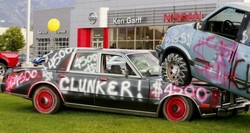Cash for Clunkers Program Turns Out to be a Clunker … Tax Payers Pay $24,000 Per Car
Posted in: Barack Obama,Business,Economy,Government,Obamanation,Obamanomics,Politics
The might have want to have called it “a lot of cash for clunkers.” Tax payers paid a total of $24,000 per clunker sold.
Turns out that the much ballyhooed Obama government cash give away program “Cash for Clunkers” was a real clunker. Under the redistribution of wealth subsidy program, a total of 690K new vehicles were sold; however, according to the automotive web site Edmunds.com only 125K of those were vehicles that would not have been sold anyway. So not only did foreign car makers make a mint off the “Clunkers” program, tax payers paid about $24K per vehicle. What a bargain. We can hardly wait to see how the government will handle health care.

Making matters worse, a fabricated incentive car buying plan contributed heavily to the US economy’s 3red quarter expansion. Of the 3.5% increase, 1.7% came from car sales. Of course what percentage of the remaining 1.8% increase was from the government subsidy first time home buyers tax break? However, that is another post for another time.
However, here is some food for thought, what is going to happen to the auto sales in the future when some 125K individuals just pushed up the date they would have purchased a vehicle and only artificially enhanced this quarters economic numbers? Also, out of the people who bought cars, how many did so because of the $4000 rebate and may not be able to pay the car loans? Sounds a bit similar to the mortgage crisis that go us into this mess in the first place. Can we look forward in the future to a bail out of the cash for clunkers participants?
The fact of the matter is that all the Cash for Clunkers program did was make 125,000 folks buy a car earlier than they normally would have du to a cash give away. That cash was your hard earned tax dollars.
So what happened when the truth came out about the unintended consequences of Obama’s Clunkers program? The White House blew a gasket. Because this “my way or the highway” White House never shoots the messenger. The defensive White House fired back in typical fashion.
“It is unfortunate that Edmunds.com has had nothing but negative things to say about a wildly successful program that sold nearly 250,000 cars in its first four days alone,” said Bill Adams, spokesman for the Department of Transportation. “There can be no doubt that CARS drummed up more business for car dealers at a time when they needed help the most.”
Is Edmunds.com, a reputable resource in the auto industry the new Fox News? I guess they are bias against Obama as well? How about the fact that they are just strictly stating the numbers without political Obama spin.
“This analysis is valuable for two reasons,” said Edmunds.com CEO Jeremy Anwyl. “First, it can form the basis for a complete assessment of the program’s impact and costs. Second — and more important — it can help us to understand the true state of auto sales and the economy.”
Edmunds.com Responds to White House Comments on Cash for Clunkers Analysis
Apparently, the $24,000 figure caught many by surprise. It shouldn’t have. The truth is that consumer incentive programs are always hugely expensive when calculated by incremental sales — always in the tens of thousands of dollars. Cash for Clunkers was no exception.
The White House claims that our analysis was based on car sales on Mars and that on Earth, the marketplace is connected. We agree the marketplace is connected. In fact, that is exactly the basis of our analysis.
It is also claimed we missed the possibility that Cash for Clunkers generated excitement and consumers bought vehicles even if they didn’t qualify for the program — a claim that has been widely supported by anecdote but by little analysis. It does, after all, seem a bit odd that masses of consumers would elect to buy a vehicle because of a program for which they don’t qualify — doubly so when you add in the fact that prices shot up during Cash for Clunkers, creating a disincentive to buy.
Return to: Cash for Clunkers Program Turns Out to be a Clunker … Tax Payers Pay $24,000 Per Car
Social Web